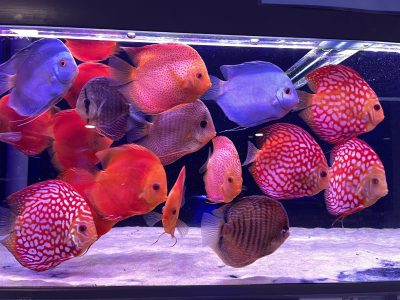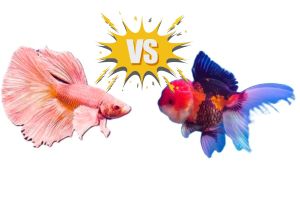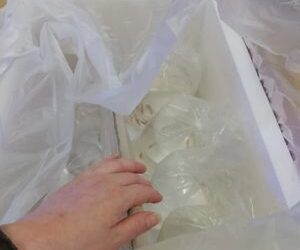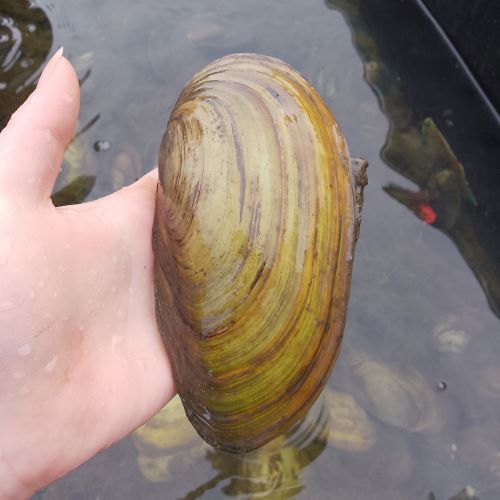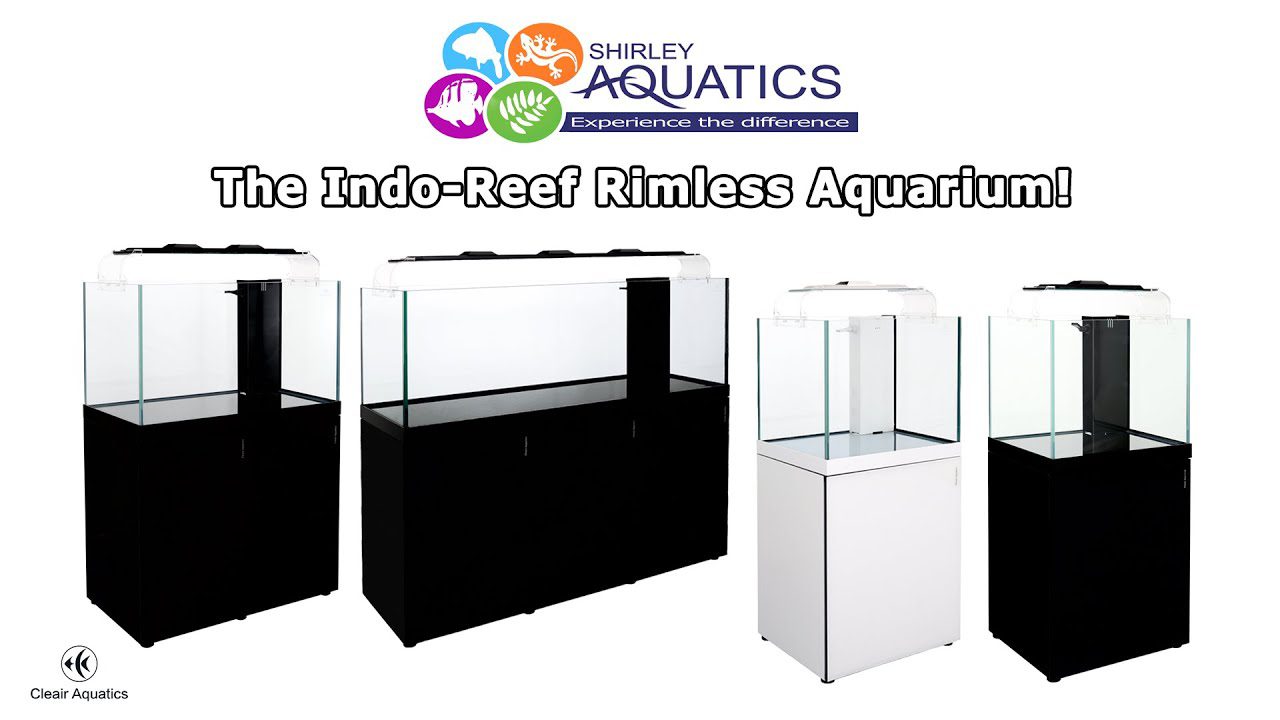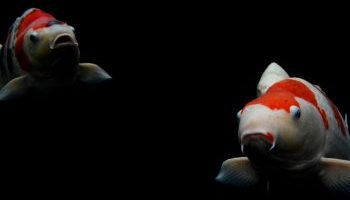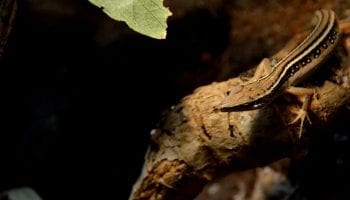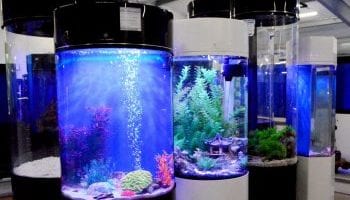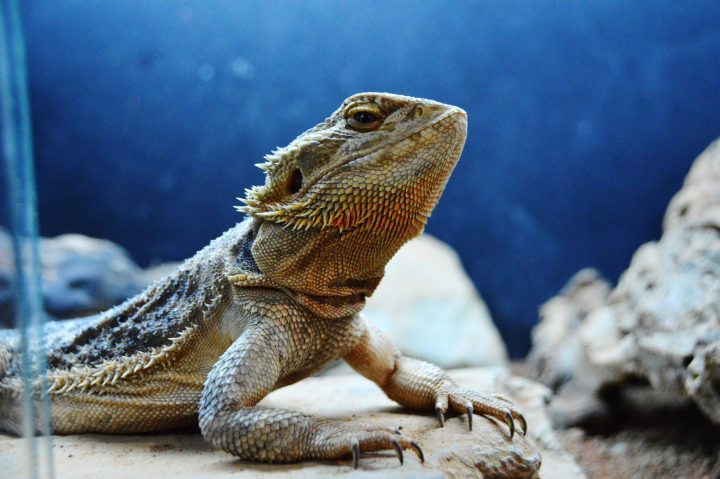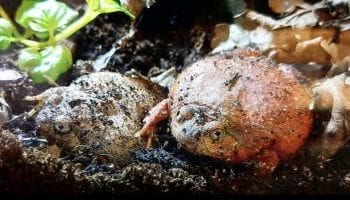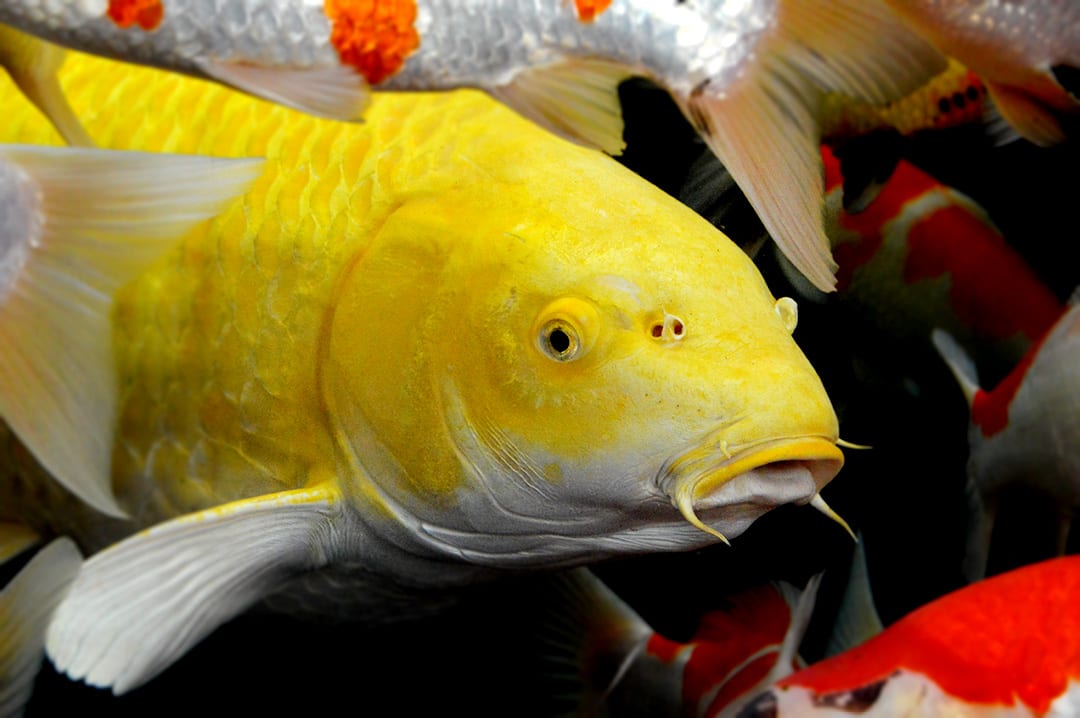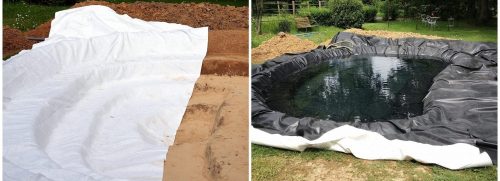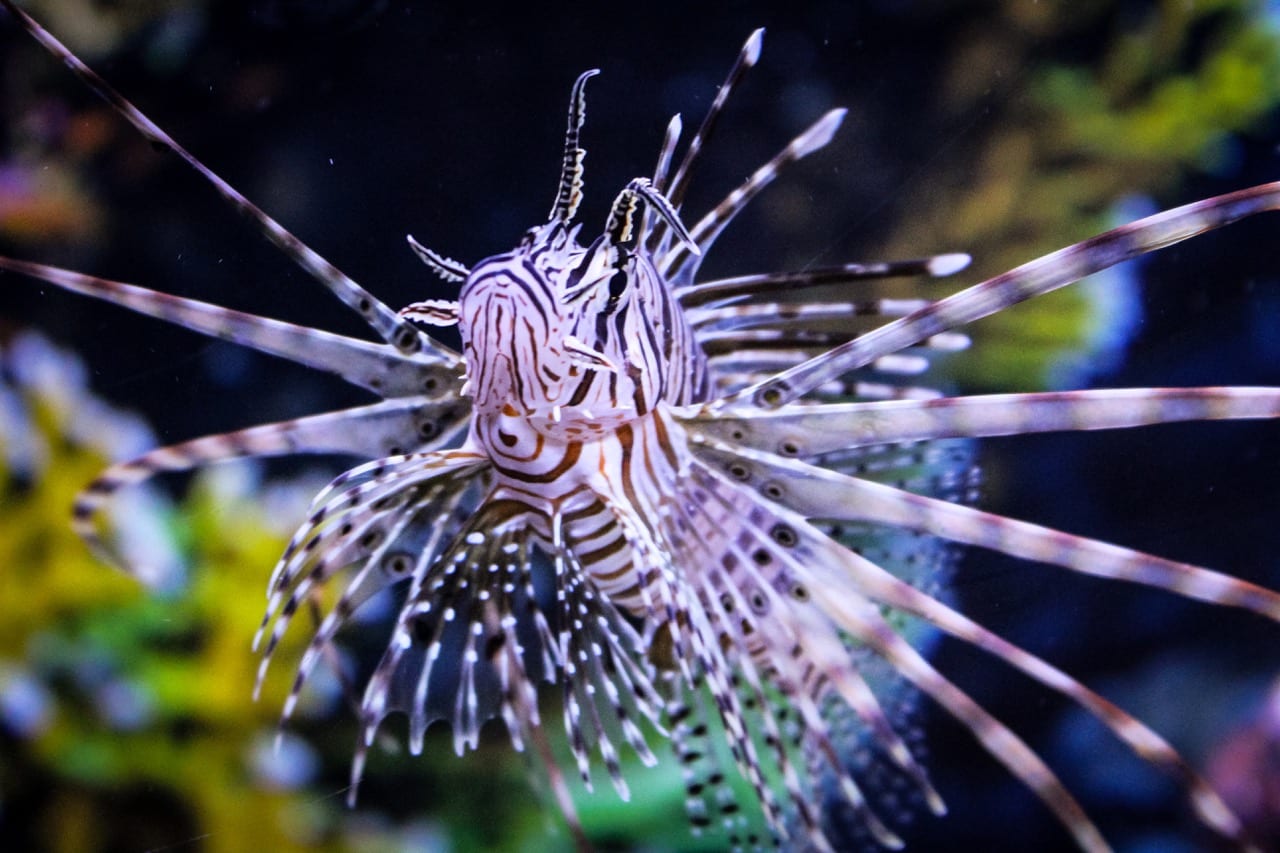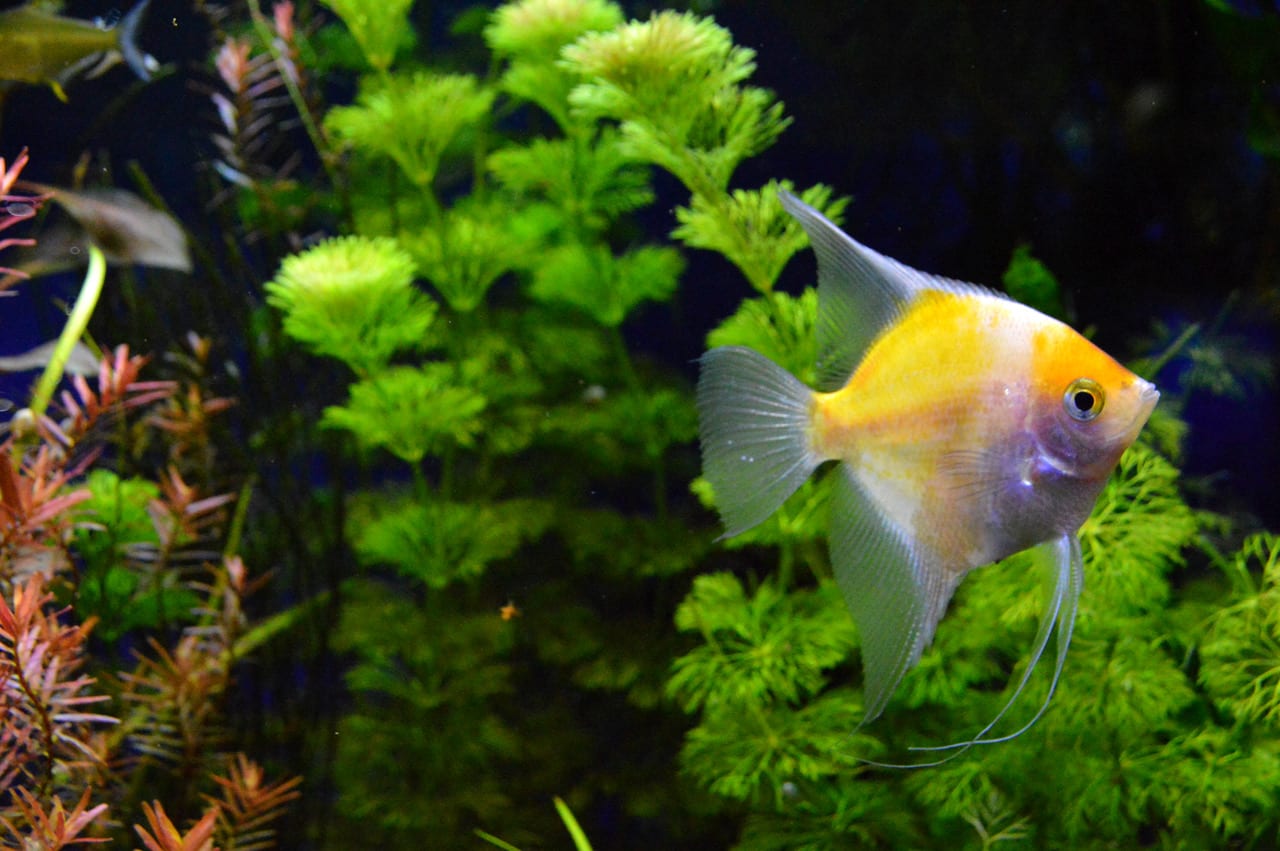The perfect Discus environment, community fish, breeding and medicating.
Discus are some of the most beautiful tropical fish you can keep. They’re very popular with experienced fish keepers but can represent a bit of a challenge for inexperienced hobbyists. This guide aims to outline all of the considerations that need to be followed for the successful keeping of Discus.
On paper (and as you’re reading through!) this will feel like a lot so we’ve broken it down into handy sections. Just remember that a lot of this is common sense and taking a bit more care of certain areas of maintenance. Once you get into the habit it becomes second nature.
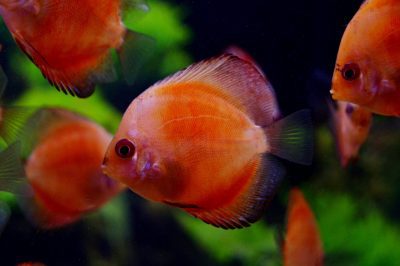
STENDKER Discus general requirements
Water
When they’re small Discus require less water than when they’re adults. ‘Duh, obviously’ you may think to yourself! But what we mean is smaller Discus prefer to have a bit less room. A wide-open tank will cause them stress as they feel exposed and threatened.
As your fish increase in size you should increase the water volume in these increments;
| Fish size in CM | Water volume per fish |
| Up to 2 cm | 1 litre |
| 2cm to 8cm | 4 litres |
| 8cm to 10cm | 5 litres |
| 14cm + | 15 litres |
Smaller fish will be calmer and will feed better in less water. At 14cm and above 30 litres per fish is perfect. Remember that Discus prefer a higher stocking density and really need to be kept in groups of at least 10. If kept in groups smaller than this they can exhibit bullying behaviour and start killing fish (see the point on classic cichlid behaviour in Part 1 of this guide)
Water Parameters
It will probably surprise you to learn that STENDKER Discus are raised in German tap water! The parameters at STENDKER would make any aquarist’s cheeks redden if the levels in their aquariums were found to be this – but this is one of the reasons the fish are so hardy.
STENDKERS water parameters are;
General Hardness (GH) – 15
Carbonate Hardness (KH) – 8
pH – 7
Water Temperature – 28 to 30 degrees Celsius
Here’s the big one…… a nitrate value (NO3) of approximately 200 mg/l.
This is 10 times the level we would recommend as the top end of what is acceptable for every other fish!
The rationale here is that the fish are used to it so if there’s a disaster in a customer’s tank they won’t all die! They state on their website they expect retail or commercial aquarists to struggle to keep perfect water all the time so they work on the assumption that the fish will be going into water at around 100mg/l (how very dare they). From there they expect the fish to go onto a customer’s home tank that might get to around 50mg/l. Each step being an improvement for the fish.
We’d like to take this opportunity to say our Nitrate values are certainly not at 100mg/l! But it’s nice to know if something went very wrong our STENDKER Discus would be absolutely fine!
Water changes
Discus require a 30% water change once a week using water from the cold tap. The reason for this is to avoid any copper than may be present from the boiler or pipes leading to your hot tap. STENDKER recommend letting your cold water tap run for 5 minutes before using the water that is flowing to ensure any stagnant water that had been standing in the pipes has gone.
Obviously this will have an impact on your temperature so some fiddling with the flow rate of the replacement water and your heater may be necessary. Remember to keep your heater submerged throughout this process or it will go pop – and nobody wants that!
Lighting & Heating
Discus should be kept at between 28 and 30 degrees Celsius. The heater should be placed in a rear corner of the tank and set to 29 degrees with a digital thermometer on the front so you can monitor your temperature. As for lighting, Discus prefer lighting that isn’t too bright. If your water depth is 40cm or less one fluorescent tube is adequate, if more than 40cm use two.
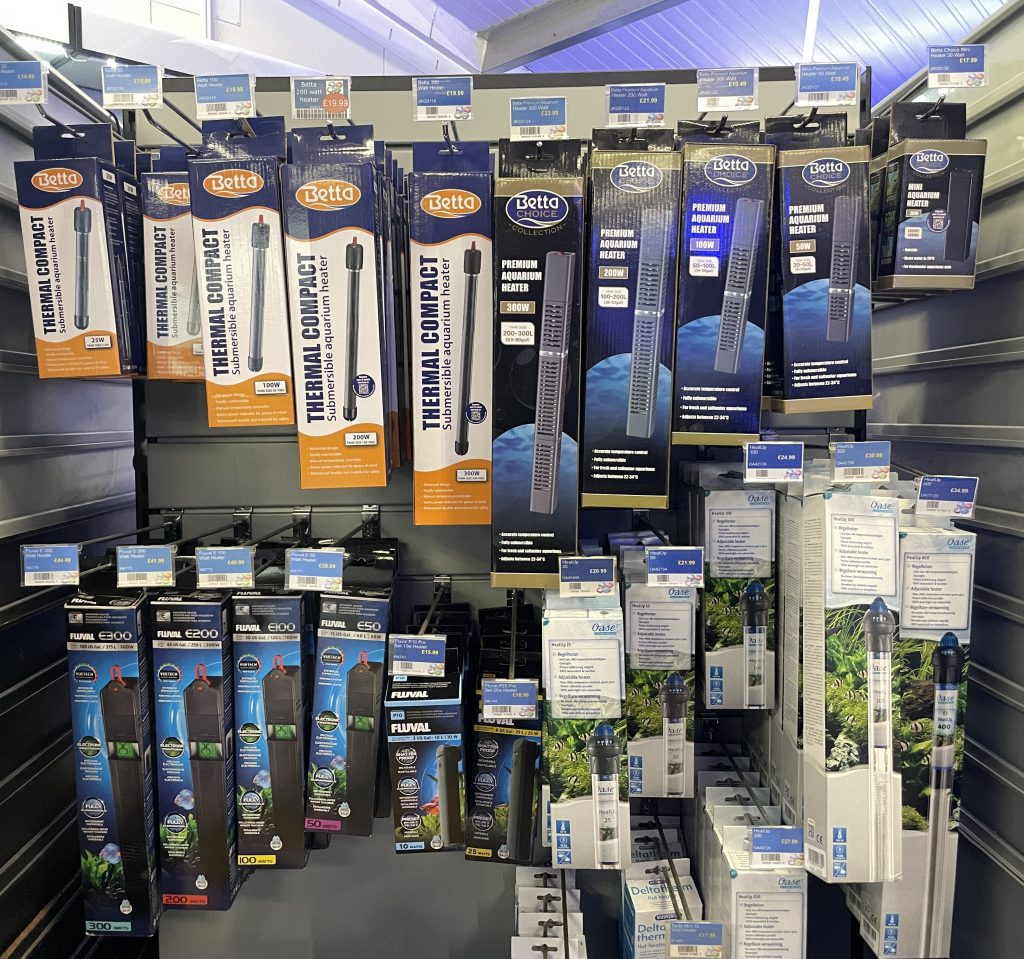
The light needs to be on for between 12 and 14 hours a day with a night light to overlap with the daylight. Discus orient themselves by the sun and moon in the wild so having two lights helps them to feel comfortable and also minimises any fright that might occur from day lights suddenly coming on from nothing. Remember to keep your lights on a timer so your Discus have a regular routine.
Additional oxygen
STENDKER advise using two additional airstones in your Discus aquarium. A great way to play around with additional oxygen is by using a Hamburg Matten filtration system like STENDKER do – if you’ve not heard of a Hamburg Matten filter check this out.
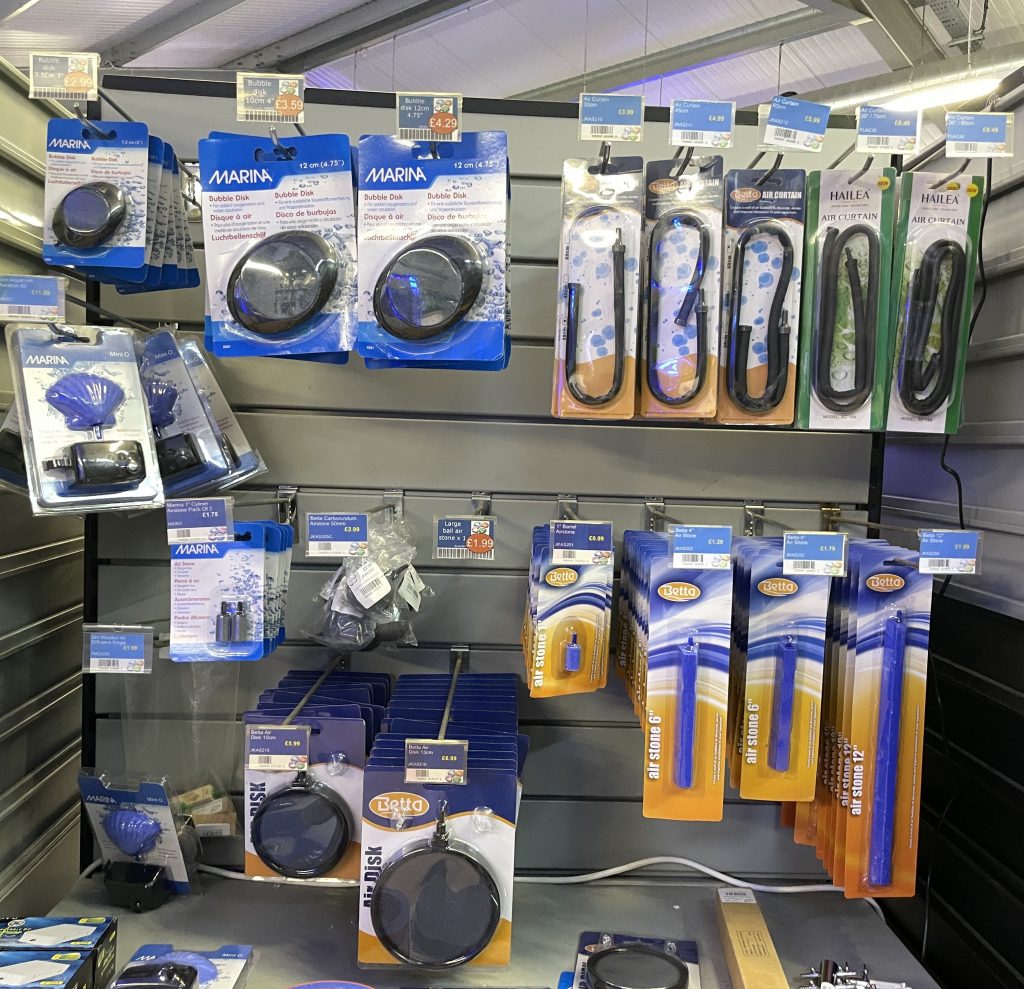
General Discus care
Introducing your discus
When putting your discus into their new tank leave them in there without the day light on for a day to let them settle in.
Feeding your Discus
STENDKER feed their discus three times a day using only their STENDKER Good Heart food and they recommend that all keepers retain this feeding schedule. Discus are creatures of habit and respond well to a set routine.

STENDKER produce three different types of food – GoodHeart Classic, Spirulina Algae, and Colour. They are sold in 100g frozen blister packs or 500g frozen flat packs. Feed your Discus at the same time every day to establish a routine and they’ll very quickly work out when it is time for food and become extra responsive to anyone approaching the tank.
As a general rule do not feed live food. Whilst Discus will eat some live food they can be very susceptible to disease and bacteria carried by some live food. For the short list of acceptable live food please check STENKDER’s website (we’d advise using Google Chrome as a browser for this so it translates from German for you). We’d rather be safe than sorry and don’t bother with live food at all.
Food prep
Remember to always completely thaw your Discus food. Frozen food can halt digestion, cause intestinal inflammation, swim bladder issues, or trigger loss of all appetite.
Don’t defrost your food in running water under a sieve – you lose a lot of the good stuff! If you have any leftover food after ten minutes it should be removed from the aquarium. Thaw your food slowly in a fridge to maintain as much of the original consistency as possible.
For fish between 6.5 and 12 cm you’ll need half and a full blister section (2.5-5 grams) per meal. So you’ll use between 7.5 and15 grams a day. For fish from 12 to 18 cm you’ll need one, to one and a half blisters (5-7.5 grams) per meal. This adds up to between 15 and 22.5 grams a day.
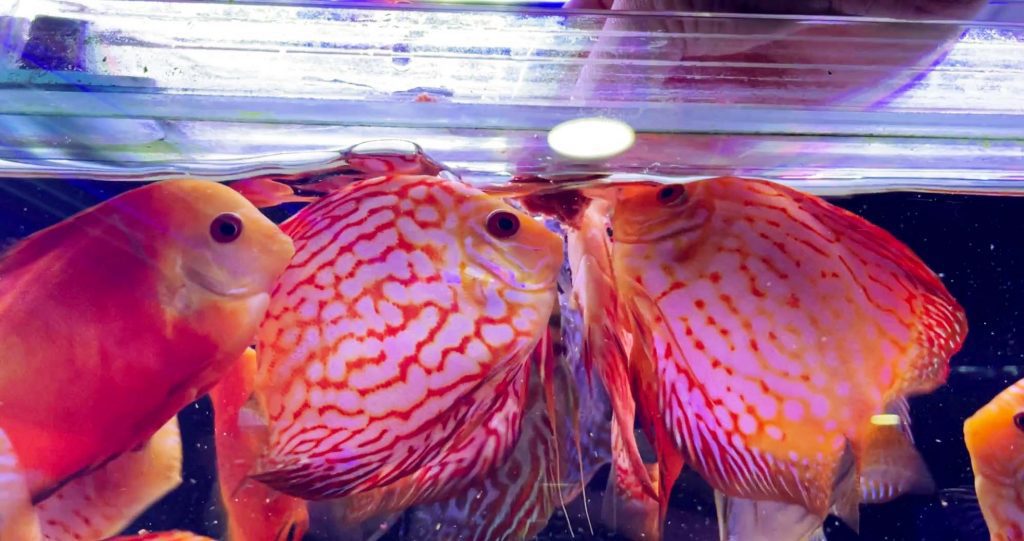
Feeding schedules
STENDKER recommend you feed your fish three times a day with their STENDKER Discus food. Once in the morning one hour after the daytime light comes on, once at midday, and once in the evening two hours before the daytime light is switched off. So, if your light is on for 13 hours a day (between 12 and 14 hours per day, remember) you may have your light timer set to be on between 7am and 8pm. In this scenario, you would feed at 8am, midday, and 6pm. The discus fish get used to these regular feeding times and will eagerly await you. Hand feeding is easy with discus – just remember to completely clean and wet your hands before interacting with your fish or their environment.
If you are unable to feed your fish 3 times a day (maybe work hours don’t allow for it), it is usually sufficient to only feed them in the morning and evening. However, the daily amount of food should remain the same.
Overfeeding
Discus do not have a pronounced feeling of satiety and too much food could lead to overfeeding of the animals. Depending on the size of the tank and the number of fish, using 2-3 feeding points has proven useful, so that the weaker animals in the group also have a good chance of getting food.

Refusal of food
After the transport and transfer of the discus fish to your tank, which is very stressful for the animals, food intake can be delayed by up to four weeks, especially for the larger fish. The smaller discus fish (up to 14 cm) are less sensitive to this, feel at home in their new environment more quickly and usually eat quite well the next day. Since STENDKER discus fish are generally well-fed, this refusal to feed does not pose a serious problem when the discus is almost fully grown.
However, if this does happen to you we recommend slowly increasing the water temperature in your aquarium to 33°C for about two weeks (remember to remove the plants beforehand!). This stimulates the metabolism of the fish, increasing appetite. Of course, maintaining a diet of STENDKER food only will help with keeping things consistent for the animals. Please remember that 36 degrees and above is lethal for discus so be very careful when operating at a higher temperature.
Aggression
If your discus are displaying aggression or restless behaviour try reducing the temperature of the tank by a degree or two. Conversely, if they’re too stiff or slow, increase the temperature by 1 or 2 degrees. Remember that 36 degrees and above is deadly to discus!
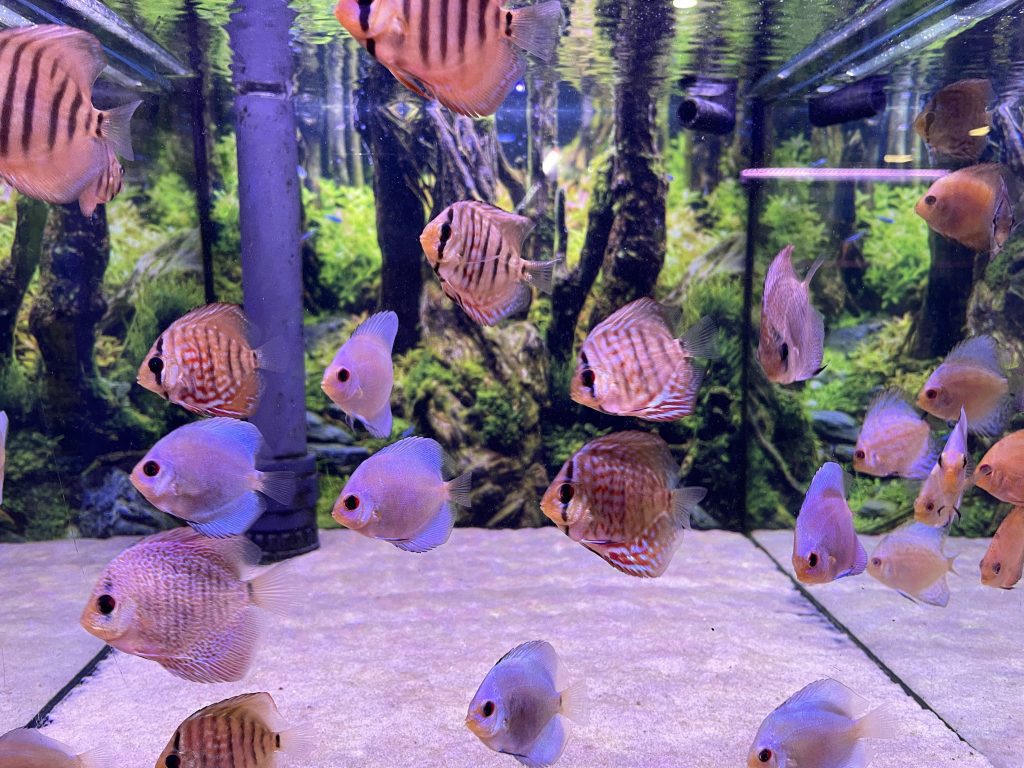
Handling your Discus
Fish aren’t typically a pet you’ll handle often but you may have to from time to time to inspect them. Just remember to always wash every trace of cream or soap off your hands with a brush before touching your discus’ water and keep your hands wet before handling the fish. This protects and maintains their mucous membranes and prevents injury.
The perfect Discus setup in 10 steps
- A tropical tank with the right amount of swimming room for the size of fish you have.
- Placed in a busy part of the house so they stay used to people moving around. Do not put them behind a door as the sudden movements make them skittish. Not in direct sunlight.
- A day and night light, both on timers. Day light to be on between 12 and 14 hours per day.
- Heater (set to 29 degrees celsius) placed at the rear of the tank.
- 2 filters, one at each end of the tank (classic canister will do, but STENDKER use Hamburg Mats), pump, 2x air stones.
- A light coloured sandy substrate – the lighter the substrate the more discus ‘colour up’ – and roots. These should be pre-washed, with all sharp ends or edges sanded down or otherwise removed, and quarantined prior to putting them into your setup.
- A group of 10 or more STENDKER Discus
- 3 feeds a day, at the same time each day, of STENDKER Discus food.
- A 30% water change once a week using water from your cold tap, not your hot tap, and a siphon clean of your substrate.
- An ‘emergency kit’ of activated charcoal, a quarantine tank, and an emergency tank. A polybox will do – discus can survive for weeks in a tank without a filter or food. Note that the operative word here is ‘survive’ not ‘have fun’ or ‘enjoy’ but if you’re in a pinch it will serve.
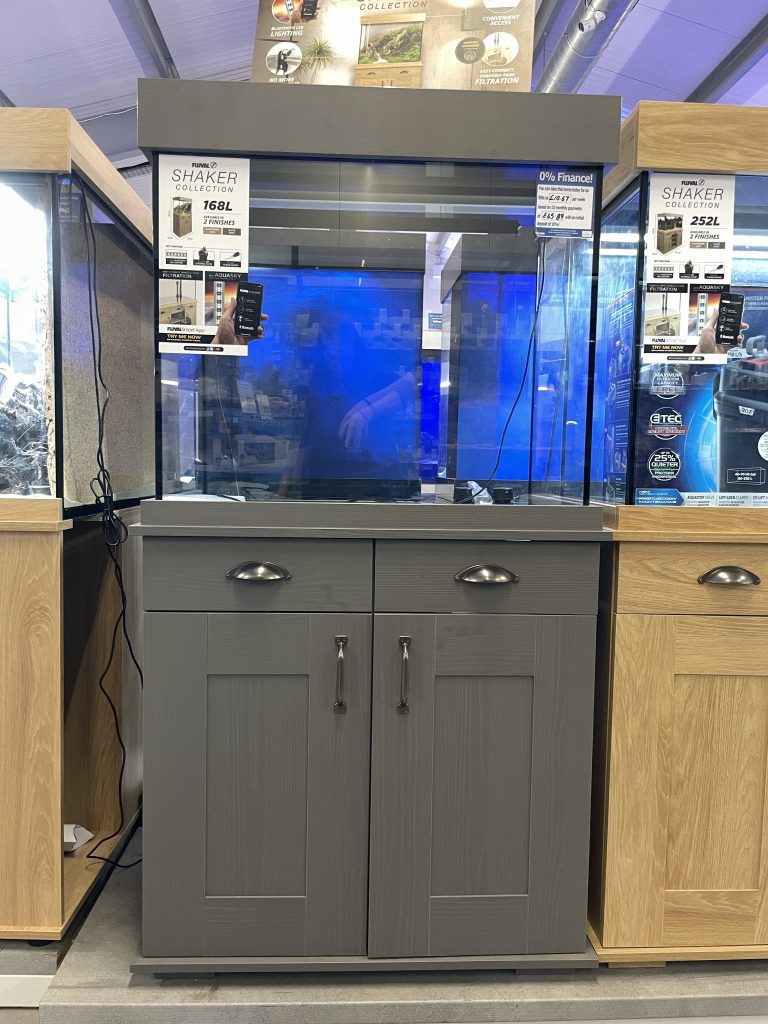
Before setting up your tank you’ll need to give it a deep clean. Wash with a vinegar and water solution then wipe dry. For a pre-used aquarium disinfect with hydrogen peroxide first. 500ml of the 30% hydrogen peroxide to every 180 litres of water. Fill your tank and mix the correct dosage (using the levels above) into the water. Leave this for 24 hours then perform a 99% water change and refill the tank with new water. Let this cycle and test continually after 7 days until happy with your water parameters.
Remember – the list above is for the PERFECT discus setup. You could get away with a single filter, you can get away with feeding at different times each day, you can get away with a planted tank (some would argue that’s better than roots and sand/gravel), and you may have no choice but to put it in view of a window. We understand that reality gets in the way of perfection – but if you want to get the absolute best out of your fish, this is the setup you need.
Adding Discus to your setup
Only introduce discus into a tank if the water temperature is within 4 degrees of each other (bag and tank). If not bring up the temp of the bag to the temp of the tank at a rate of 1 degree an hour before introduction.
A note on filters
STENDKER only use Hamburg Matten filters in their setups. This is essentially a sponge filter with an air and water uptake across the top to generate flow. It’s very simple and fun to make yourself but may be a bit daunting to a novice keeper. If you’re at all unsure then stick to what you know – a classic canister filter will do fine.
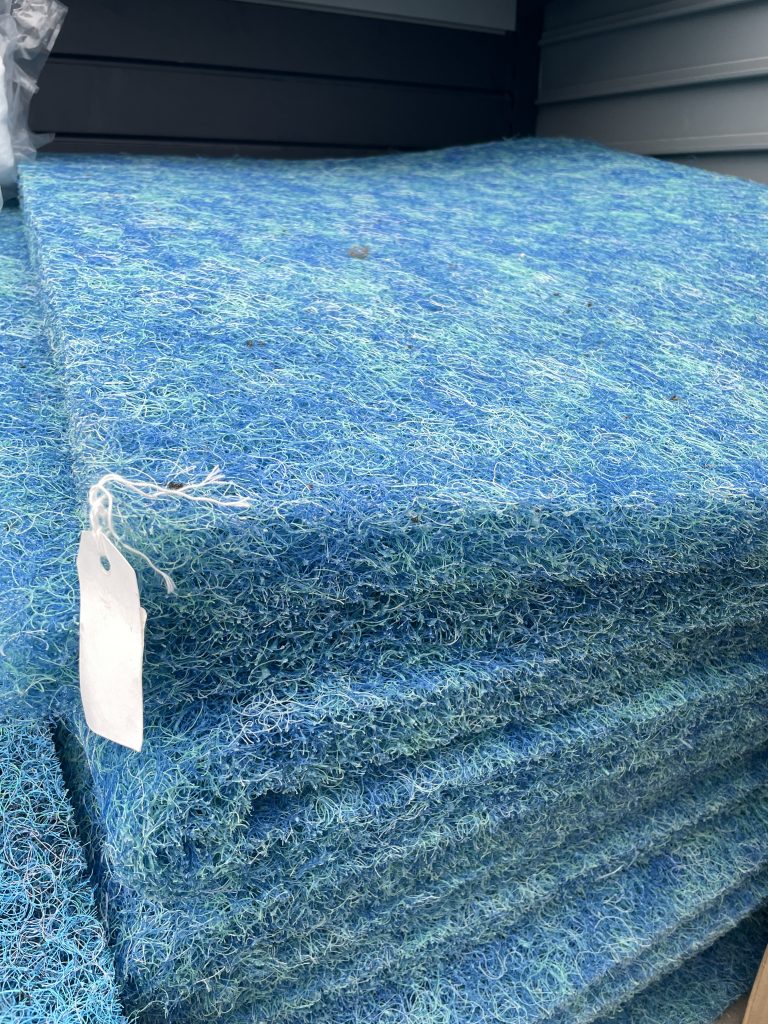
STENDKER have not cleaned their filter mats in 25 years yet have immaculate water due to the well-established bacterial colonies in them. They also prefer them as the mat itself can be moved to reduce swimming space for younger or smaller fish to feel more comfortable, can increase food jealousy (which sounds bad but is a good thing!), and generally allow discus to feel more comfortable. STENDKER unreservedly recommend these mats as the best and simplest aquarium filtration system for discus. They also say it provides optimal growth conditions for their animals.
If you want to give the Hamburg Matten method a go but are put off by the aesthetics STENDKER say you can slit the foam and put some plants directly into it (once it’s established with a bacterial colony) to soften the look.
What fish can I keep with Discus?
STENDKER suggest keeping no other fish with your Discus but they do take suggestions from credible sources. For example, following advice and evidence from Adrie Baumann (World Aquascaping Champion) they have compiled a list of fish that will live well with discus. It is important to note that these are all kept at the 28 – 30 degree temperature setting Discus need. It is also noted that it’s advisable to provide dry food to Discus tankmates. This helps the Discus maintain their food for themselves, gives variety to the tank mates that may be used to a more eclectic diet and also keeps the cost down a bit!
STENDKER also recommend buying all companion fish and plants from the same dealer, as close together as possible, and run through their quarantine system – see bacterial intolerance <insert anchor link> – to avoid possible bacterial infection.
| Tetras | Bottom Feeders | Cichlids | Other |
| Cardinal | Adolfo’s Cory | Agassiz’ Dwarf | Otocinclus** |
| Rummynose | Threestripe Cory | Cockatoo Dwarf | Red Gara*** |
| Yellow Congo | Sterbai Cory | Butterfly* | Siamese Algae Eater |
| Blue Congo | Zebra Plec | Ram | Amano Shrimp |
| Penguin | Stonelapping Minnow | Red Line Dwarf | |
| Rosy | Whiptail Catfish | ||
| Black Flag | |||
| Neon | |||
| Black Phantom | |||
| Lemon | |||
| Golden |
- *If you’re including Butterfly Cichlids then be aware they may need a breeding ground. Half a coconut with a hole in it, or a slab of stone as a breeding ground will make them feel more comfortable.
- **Otocinclus are best used in planted tanks as they keep plants beautifully clean.
- ***Red Gara are the fish that they use to nibble your feet in some clinics! Please, save them from this awful fate.
Catfish are great to help with algae but any catfish that gets above about 15cm in length will like to nibble on discus from time to time which is obviously best avoided. Keep an eye out!
STENDKER strongly advise not to keep discus with Angelfish. Angel’s carry tapeworms which they have adapted to cope with but discus do not. These worms can and will kill your discus.
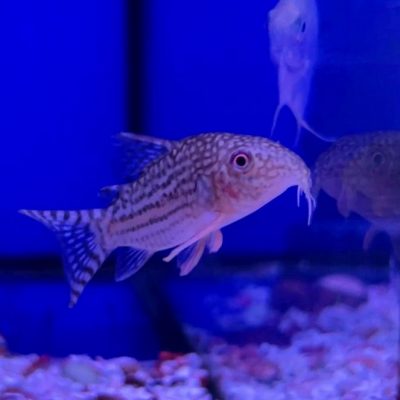
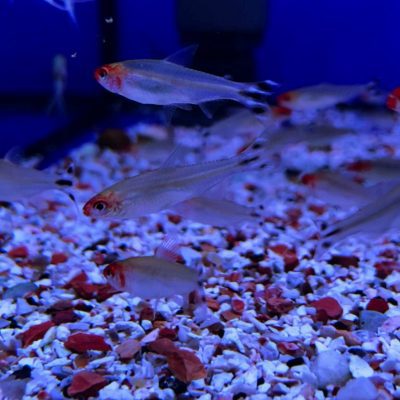

What plants can I have with discus?
The main consideration when it comes to plants in a discus tank is the heat. You should be looking at only using plants that can withstand that kind of temperature. This narrows your options to plants like Oak Leaf, Cabomba, Vallisneria, and various Echinodorus (like Amazon Swords).

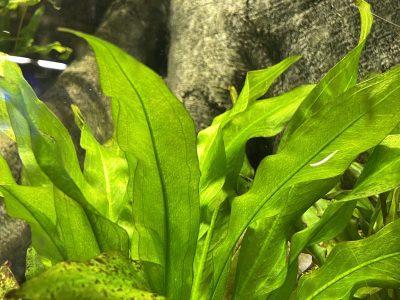
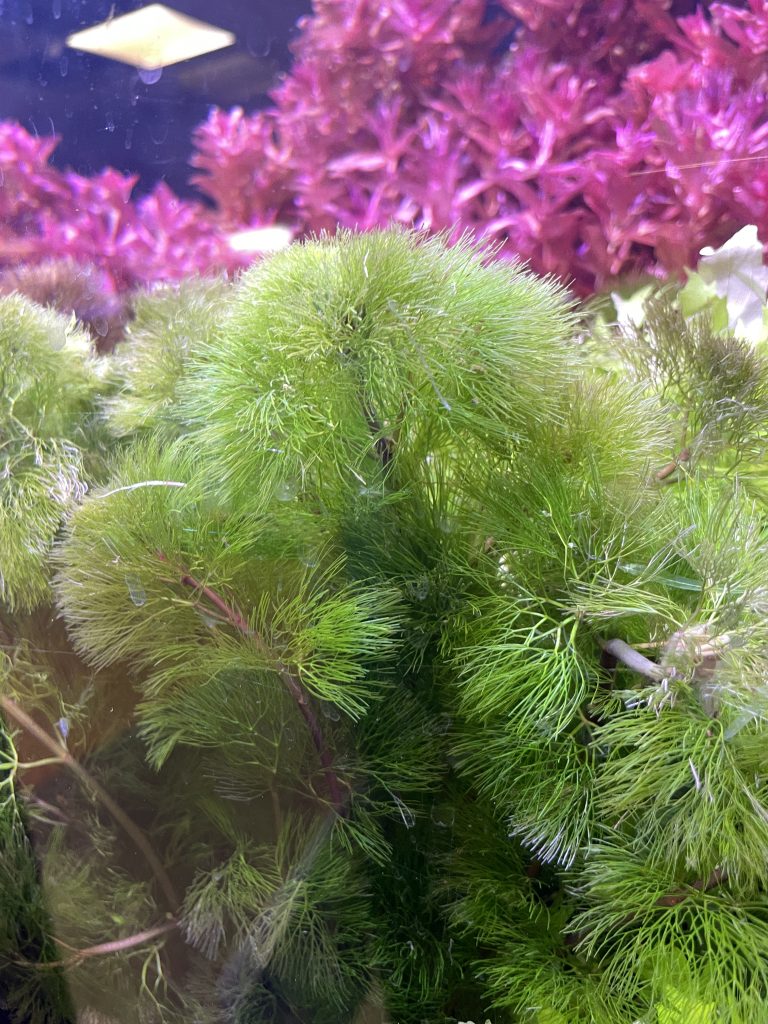
STENDKER have published a complete list of plants they would recommend – we’ve not listed them all here as not all are available in the UK but if you would like to look at the whole list click here.
Discus treatments
As with all fishkeeping, you will at some point have problems. This could be something simple like whitespot or something more complicated like a bacterial infection or hole disease. Knowing what to do before this happens removes a lot of the stress from the situation and generally makes your life (and the lives of your fish!) easier.
Quarantine
if you notice Discus refusing food or passing white waste they need to be moved to a quarantine tank. This tank should be kept at 33 – 34 degrees celsius. This increased temperature accelerates their metabolism, improves food intake, optimises digestion and the immune system of the fish. Remember that 36 degrees and above is lethal to discus so be careful! This temperature treatment is preferred to drug use by STENDKER. This treatment can be continued until the fish is better and deposits dark droppings for at least three days. Remember to feed your discus three times a day during this period, netting out whatever is not eaten.
Salt bathing your discus
Salt bathing removes external parasites from fish. It’s a common practice in pond keeping but less seen with tropical fish, despite being very effective.
Take 15 litres of your tank water and dissolve 500 grams of iodine-free salt (wait 2-3 mins for this to dissolve). Then let your Discus swim in this water for 30 – 60 seconds before putting them back into the original tank. Please be aware that you must not let your discus swim in this water for longer than a minute. It will kill your fish within 5 minutes if left in there. If the fish is already very weak before the treatment then keep this to 30 seconds and transfer them to a separate tank to recover.
Hole Disease
Sounds hideous, and looks bad, luckily it’s easy to fix with an ointment treatment. Nystatin Antifungal Ointment (does not contain zinc) works in 90% of cases but is unfortunately not available over the counter at pharmacists in the UK. We use Octozin tablets or, if the holes are large enough to warrant it, an anti-bac spray treatment similar to what we would use on a koi.
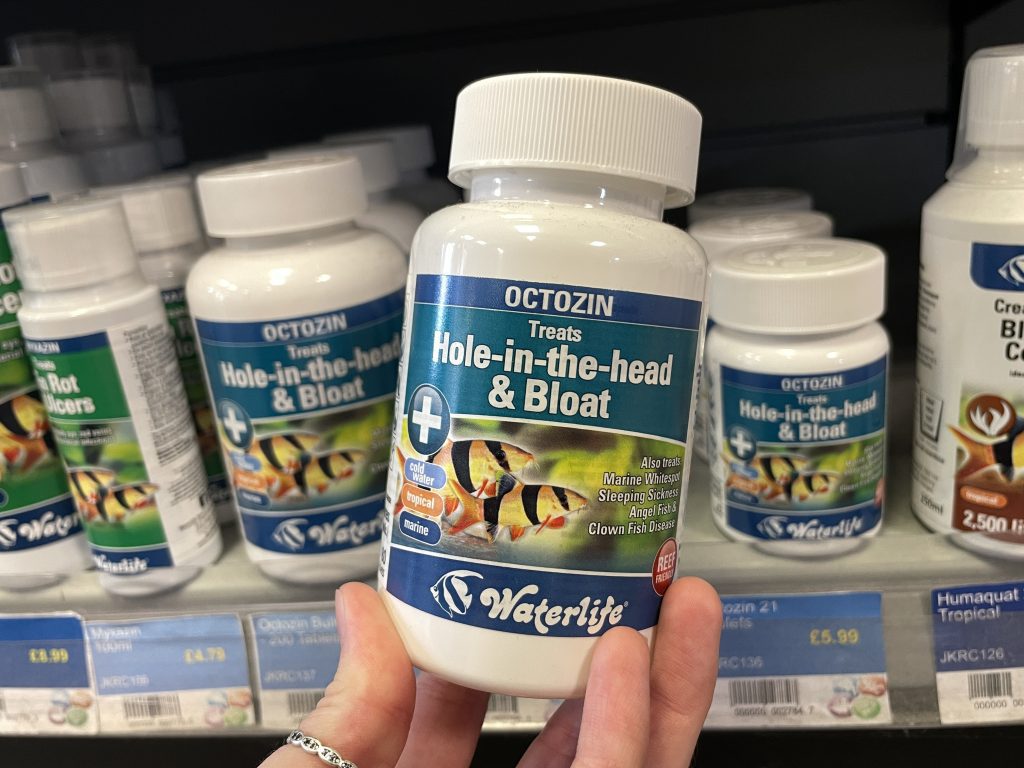
Hole disease is mainly attributed to mineral deficiency so it’s worth checking your water hardness, particularly if you’re local to us as we have very soft water. We would always advocate water and dietary fixes before treatments. A run-through of your initial checks should include Kh & trace elements in the water, potassium, phosphorous, and vitamin D in the diet.
Hole disease manifests as pimple-like spots on the discus’s head that later burst, leaving craters in the skin.
Applying topical (skin) treatments
In the unlikely event you manage to get your hands on some Nystatin you’ll need to know what to do with it. Catch the fish and lay it on it’s side on a (clean) damp cloth. Dab the holes dry with kitchen roll and apply the ointment with your fingers. With a bit of practise this whole exercise can take between 30 and 60 seconds but don’t fret if you’re slower to start with – a fish can easily spend 3 to 5 minutes out of water.
A single treatment is usually enough for smaller holes. For holes larger than 5 mm repeat the treatment weekly until healed. Our biggest tip for this is just to get stuck in. A little bit too much ointment isn’t the end of the world, it’s not hurting your fish, and you can’t catch it. The quicker it’s sorted the happier both you and your fish will be.
Nitrite poisoning
If you notice your discus refusing food and breathing heavily it’s a sign your nitrite levels are too high. Test your water to make sure. If your nitrites are too high you’ll need to perform a 90% water change. They will start feeding again once the nitrite and ammonia levels are down again.
Use warm water as close to 29/30 degrees as you can make it for these water changes, cold water of that quantity would obviously crash the temperature of the tank far too much. Remember during large water changes to make sure your heater, pump, and filter stay submerged for as long as possible and spend the least amount of time possible absent from use. Never run your heater out of water.
General water toxins
If your discus become shy, jumpy, or hide away at the back of a tank after a water change it can be an indication of toxins in your water. This can be prevalent in spring and early summer as farming pesticides etc can filter into our tap water. If this does happen STENDKER recommend using activated charcoal as an additional level of filtration.
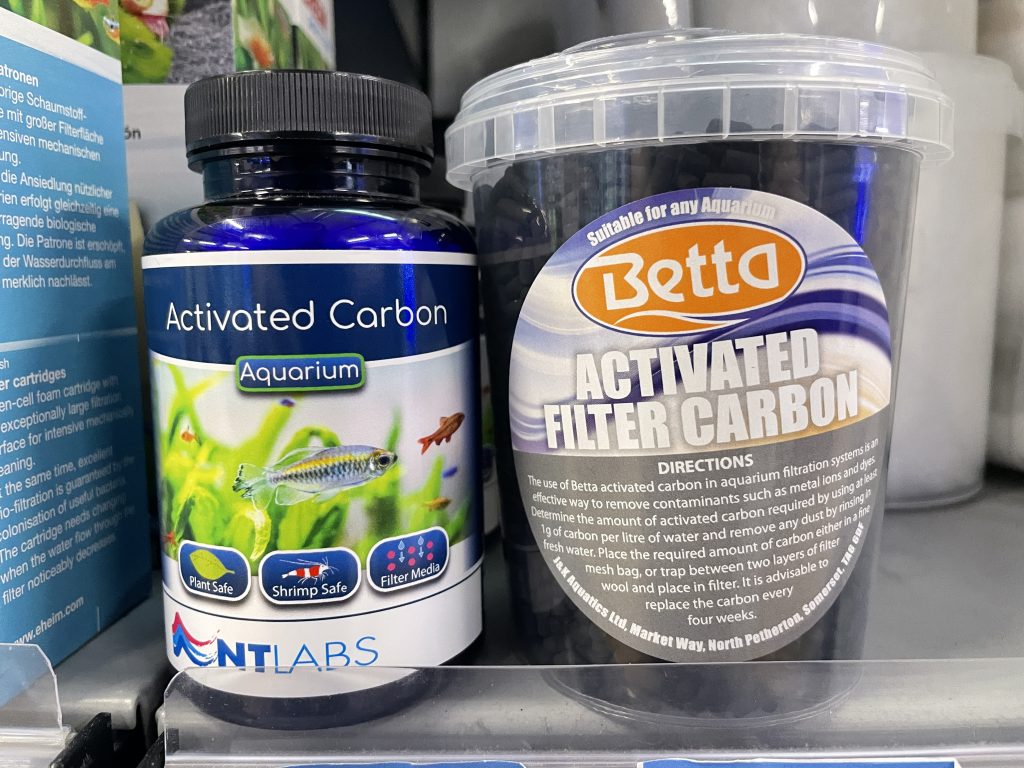
Place about 500g in your filter (having thoroughly rinsed it first until the water runs clear!), or at the outlet of your filter so the water flows through it, for two weeks. Do not leave it in your filter for any longer than 3 weeks or it will become saturated and begin releasing the stored toxins back into your water!
Bacterial tolerance testing (using a quarantine tank)
Before adding plants or new fish to your main tank it is advised to hold them in quarantine for a week. This rules out the possibility of introducing bacteria or disease into your tank. Remember, as highly bred animals Discus are very susceptible to disease or bacteria they’ve not encountered before. They have no resilience to them.
STENDKER recommend a 60l tank with complete filter, heater, and air stone set up at the correct temperature. Put your new fish and/or plants in with a ‘test’ discus from your main tank. Use a variety that can turn dark (so not pigeon-blood). If bacterial intolerance occurs the fish will usually go dark after a few days and seek a corner of the tank. They may also clamp their fins to their side.
A Ciano 60 is a perfect option for a quarantine tank. They’re inexpensive and come with heater, filter, and lighting all included. We often recommend them as starter aquariums for this reason but they make great quarantine options, too. Pink gravel is optional…
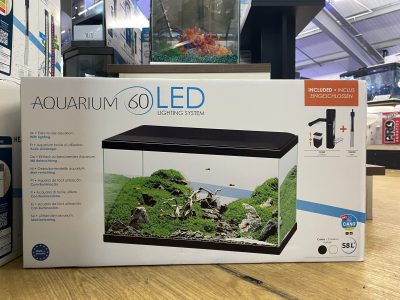
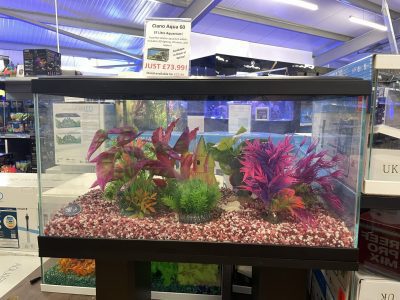
If this happens the safest thing to do is to get rid of all of the contents of the quarantine tank and not put any of the fish or plants into your aquarium. On the other hand, if everything is fine after a week you can put everything into your main tank.
During the test week make sure no water at all (even the slightest drip) from the quarantine tank can get into your main tank.
Bacterial Compatability
We (and STENDKER) strongly advise against mixing STENDKER discus with any other discus (Asian or wild caught). Cross contamination and bacterial infection is both likely and lethal.
Holiday Care
From around the size of 10cm discus can last 2-3 weeks without food. Older and larger Discus can even manage 1-2 months. Such fasting periods can happen in nature and can even benefit the fish’s health. STENDKER even say there’s no need to change water during this time due to so little water contamination. If you are happy to do this we’d recommend carrying out water tests to keep an eye on your ammonia during this time as the breathing process of fish can contribute a fair amount to your ammonia levels.
To prepare your fish for this fasting period it helps to decrease the temperature to 27 degrees celsius. This will slow their metabolism and curb their hunger somewhat to help them through extended fasting periods. After a fasting period (like you going on holiday) it’s important to reintroduce food slowly and gradually increase the number of meals per day back to pre-fasting levels.
They’re also likely to be hungry and a bit grumpy (wouldn’t you be?) so you might get a nip or two. If bitten by your discus just press on the area until a spot of blood comes out. This will remove the small chance of infection from the bite itself.
Substrate cleaning
If your fish are suddenly no longer trusting, jumpy, breathing heavily, or darkening after weeks of everything being fine it may be hydrogen sulfide poisoning from the substrate. You’ll notice bubbles escaping from the substrate if it is distrubed – this is a classic sign of trapped putrefactive gasses. Clean the substrate with a classic siphon once a week to avoid this build up.
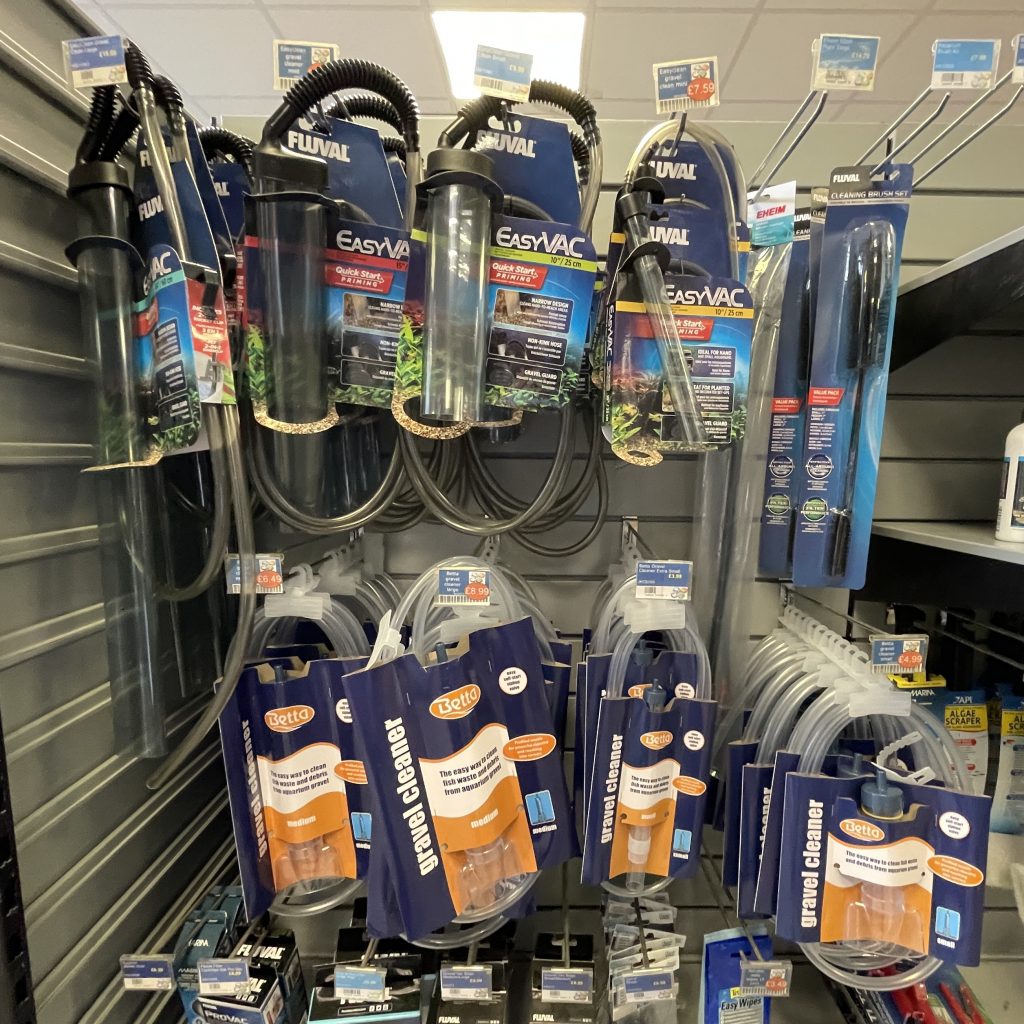
Breeding Discus
With the sad news that STENDKER are finishing their breeding programme they have released their recommendations and guide to breeding your own! They’ve laid out four different scenarios that fish keepers or fish stockists may want to consider for their own breeding purposes so we’ll lay these out below. This is predominantly based around how much space you’ll need for each setup.
Breeding from a pair
Keep a pair of discus in an aquarium size of 150 litres set up the discus specifications outlined above. We really would recommend you try for as close to the ‘perfect setup’ (see above) as possible for breeding – you want mum and dad to be as happy as possible! Provided they are a male and female (we thought this bit was obvious so didn’t specify!) nature should take its course. Once the young fish are 12 – 14 days old remove the parent fish as they may begin foraging at the bottom of the tank and could ingest pathogens in the substrate.
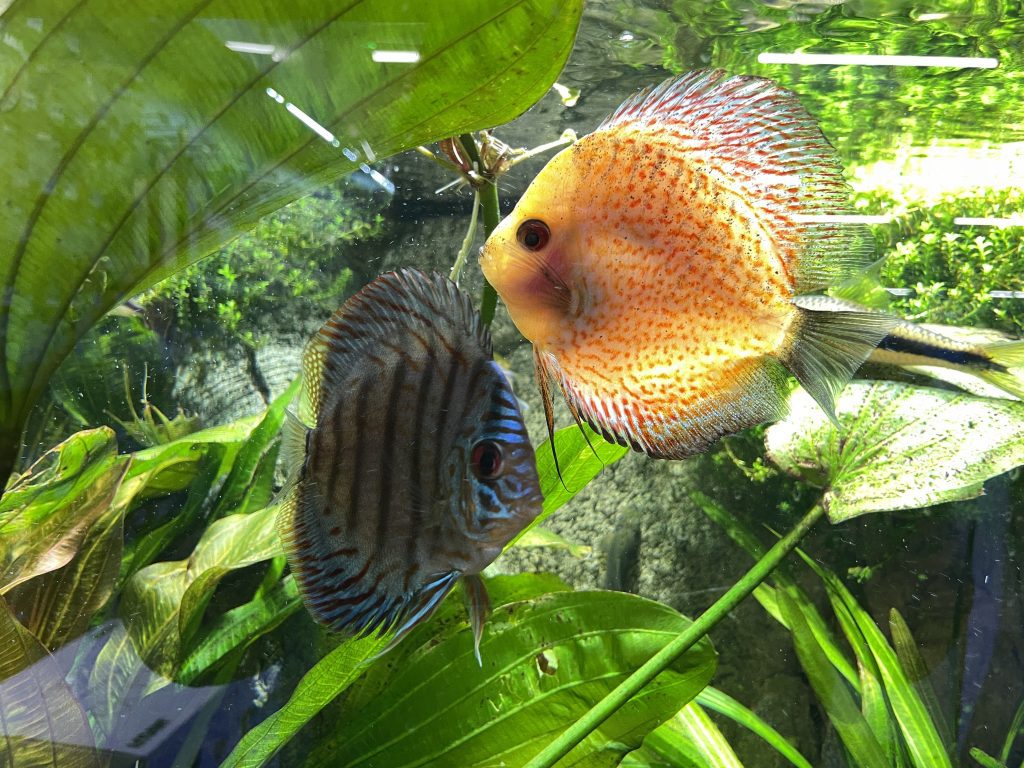
Breeding from a pair with companion fish (with or without plants).
You’ll need a tank of at least 180 litres for this option (STENDKER recommend 250 litres). When keeping in pairs within a community you shouldn’t try to breed pairs smaller than 14cm tall due to food jealousy with tankmates. Keep an eye on tank mates – if they’ve been with the discus for some time they shouldn’t eat the babies, but them might! If they do you’ll need to put the babies in a quarantine tank set up for discus until they’re big enough to hold their own.
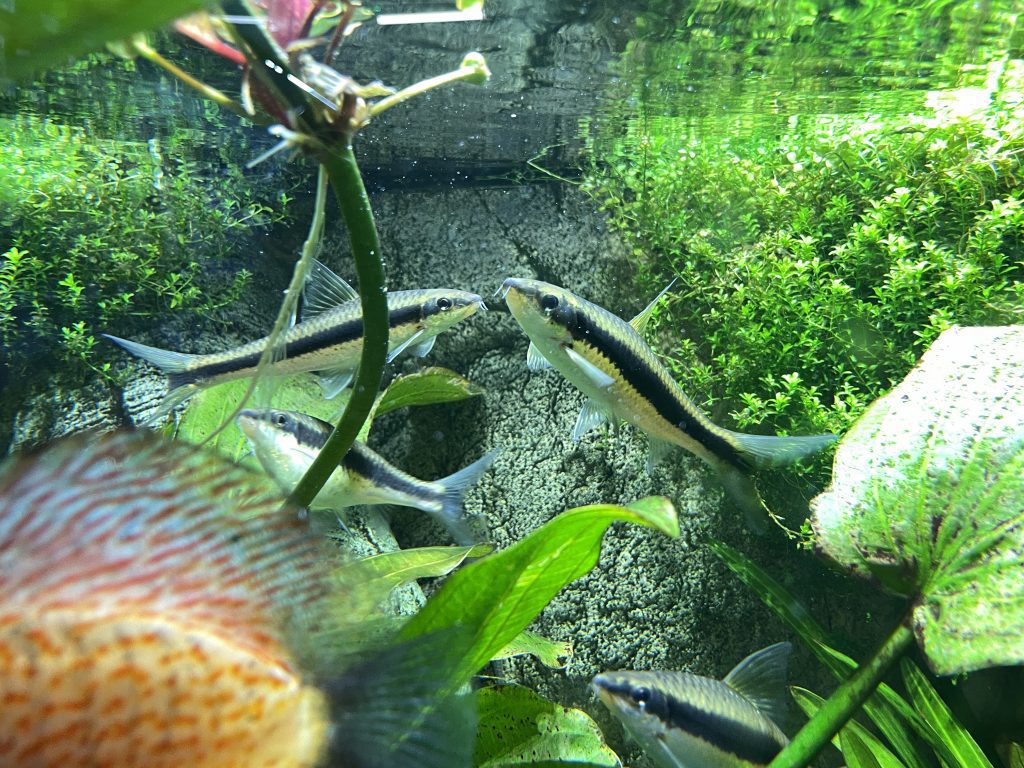
Group husbandry (10 or more adult discus)
For a group of 10 or more adult animals you’ll need a 300 litre tank. As with option 1 – try to get as close as you can to the perfect setup. The better the environment the higher your likelihood of successful pairing and breeding.
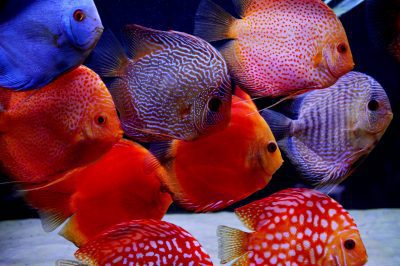
Group husbandry in a planted aquarium with companion fish
Minimum aquarium size of 400 litres for 10 adult discus fish including companion fish and plants.
Things to consider before you get started
1. Decide in advance if you’re going to keep discus groups or discus pairs
2. Make sure your setup is as close to the perfect setup as possible. Make your decision on discus, companion fish, and plants – and buy them all at the same time.
3. Do not restock or add to the tank once you’ve started. This reduces the risk of disease or bacterial contamination – which would be lethal to young fish!
4. Feed 3 times a day with STENDKER discus feed, which is ideally suited as a complete discus feed solution and also eaten by other fish.
5. 1 weekly water change of 30% with cold water!
6. The ideal keeping temperature for discus fish is 28-30° Celsius.
7. 12-14 hour light control with a timer and night light is recommended (to help with orientation and to avoid being startled.
If in doubt
There you have it, just a few little things to remember! On a serious note please use this article as a reference point as and when you’re unsure about any aspect of discus care. If there is something we’ve not covered here – or you just prefer speaking to someone – feel free to give us a call at any time and our fish room staff would be delighted to talk you through your issue.


